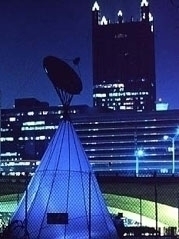非常抱歉,
你要访问的页面不存在,
非常抱歉,
你要访问的页面不存在,
非常抱歉,
你要访问的页面不存在,
验证码:

职称:Professor of Art
所属学校:Carnegie Mellon University
所属院系:art
所属专业:Art/Art Studies, General
联系方式:
Bob Bingham makes art that incorporates systems of growth, live plants and natural materials with mechanical and electronic devices. Through this combination of systems he addresses issues pertaining to a sustainable future where technology and nature exist in a symbiotic relationship. Bingham¹s work has been widely exhibited in the United States, Italy and Japan including The Institute of Contemporary Art, Philadelphia; The Brooklyn Museum; The Andy Warhol Museum; Mattress Factory; Ecovention, Contemporary Arts Center, Cincinnati; Kanagawa Hall Gallery, Yokohama, Japan; Art+Nature, Rico Gallery, Santa Monica; and Urban Paradise/Gardens in the City, Paine Weber Art Gallery, New York. He has had many public installations including Creative Time¹s Brooklyn Bridge Anchorage; in Piazza del¹ St. Stepheno Rome, Italy and the first Pittsburgh Center for the Arts Biennial. He co-directed an interdisciplinary team effort, The Nine Mile Run Greenway Project that culminated in exhibits at the Wood Street Galleries and the Regina Miller Gallery, CMU, Pittsburgh. This greenway project led to the formation of the Nine Mile Run Watershed Association and the largest ecological urban stream restoration in the USA. Bingham received a BA in art from Montana State University, Bozeman and a MFA from University of California, Davis. He is currently Professor of Art and a Distinguished Fellow in the STUDIO For Creative Inquiry at Carnegie Mellon University. His work has been acknowledged with awards and grants including the National Endowments for the Arts, Pennsylvania Council on the Arts, Pollock-Krasner Foundation, Art Matters, Inc., Three Rivers Environmental Award, The Heinz Endowments and several Berkman Faculty Development Fund Grants. His art practice evolved from “green” mixed media installations into the public realm to address issues of interconnectedness between the natural and built environment. This evolution directly affected his approach as a teacher. Bingham created a new course, Environmental Sculpture, in 1996 as part of the Environment Across the Curriculum Initiative at Carnegie Mellon. Later as a member of the University’s Green Practices committee, he advised a student project and taught a course to conceptually design and assist the implementation of a “living roof” on campus. Another collaborative project, Greenscape, was created in conjunction with the School of Architecture’s Design and Build Studio to literally grow the 2007 Solar Decathlon House. As part of the Greening of Early Undergraduate Education Initiative, he began teaching a university-wide course, EcoArt, involving a collaboration with the Pittsburgh Parks Conservancy to address removal of invasive species, soil retention issues and raingardens in Phipps Run, Schenley Park. This course now continues at a variety of other locations and with other organizations. Currently he is working through the Coleman Center for the Arts on a long-term collaborative project, One Mile Garden, to establish a community-based urban farming and food distribution program in York, Alabama. Bingham continues his mission to create proposals for growing all the buildings on the planet and to change the perspective Œfor the birds’ and the humans via Google Earth.
Bob Bingham makes art that incorporates systems of growth, live plants and natural materials with mechanical and electronic devices. Through this combination of systems he addresses issues pertaining to a sustainable future where technology and nature exist in a symbiotic relationship. Bingham¹s work has been widely exhibited in the United States, Italy and Japan including The Institute of Contemporary Art, Philadelphia; The Brooklyn Museum; The Andy Warhol Museum; Mattress Factory; Ecovention, Contemporary Arts Center, Cincinnati; Kanagawa Hall Gallery, Yokohama, Japan; Art+Nature, Rico Gallery, Santa Monica; and Urban Paradise/Gardens in the City, Paine Weber Art Gallery, New York. He has had many public installations including Creative Time¹s Brooklyn Bridge Anchorage; in Piazza del¹ St. Stepheno Rome, Italy and the first Pittsburgh Center for the Arts Biennial. He co-directed an interdisciplinary team effort, The Nine Mile Run Greenway Project that culminated in exhibits at the Wood Street Galleries and the Regina Miller Gallery, CMU, Pittsburgh. This greenway project led to the formation of the Nine Mile Run Watershed Association and the largest ecological urban stream restoration in the USA. Bingham received a BA in art from Montana State University, Bozeman and a MFA from University of California, Davis. He is currently Professor of Art and a Distinguished Fellow in the STUDIO For Creative Inquiry at Carnegie Mellon University. His work has been acknowledged with awards and grants including the National Endowments for the Arts, Pennsylvania Council on the Arts, Pollock-Krasner Foundation, Art Matters, Inc., Three Rivers Environmental Award, The Heinz Endowments and several Berkman Faculty Development Fund Grants. His art practice evolved from “green” mixed media installations into the public realm to address issues of interconnectedness between the natural and built environment. This evolution directly affected his approach as a teacher. Bingham created a new course, Environmental Sculpture, in 1996 as part of the Environment Across the Curriculum Initiative at Carnegie Mellon. Later as a member of the University’s Green Practices committee, he advised a student project and taught a course to conceptually design and assist the implementation of a “living roof” on campus. Another collaborative project, Greenscape, was created in conjunction with the School of Architecture’s Design and Build Studio to literally grow the 2007 Solar Decathlon House. As part of the Greening of Early Undergraduate Education Initiative, he began teaching a university-wide course, EcoArt, involving a collaboration with the Pittsburgh Parks Conservancy to address removal of invasive species, soil retention issues and raingardens in Phipps Run, Schenley Park. This course now continues at a variety of other locations and with other organizations. Currently he is working through the Coleman Center for the Arts on a long-term collaborative project, One Mile Garden, to establish a community-based urban farming and food distribution program in York, Alabama. Bingham continues his mission to create proposals for growing all the buildings on the planet and to change the perspective Œfor the birds’ and the humans via Google Earth.